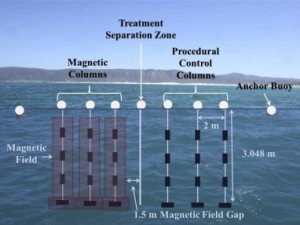“Nearly 700 sharks have been killed in the last year in Queensland’s shark control program, but a conservation group says there is no evidence it actually works.”
I was appalled to hear news of the shark cull that was initiated in Australia this year and posted an “alternative to shark culling” in June. The post details the importance of sharks and an alternative in the form of a specially designed wetsuit. That was a single example of the alternatives to shark culling, and there are many more. This post will highlight the application of a handful more alternative techniques.
* Magnets *
Beach nets prevent interaction between beachgoer and shark. However, the great white shark is often captured and killed in South African waters, in these nets. Conservation efforts are pertinent to the survival of a variety of elasmobranch species, especially C. carcharias (Great White shark) due to their low fecundity. This study by O’Connell et al (2006), aims to reduce mortalities of this using magnets as a deterrent.
Sharks have an electrosensory system that can be overstimulated by the presence of a magnetic field greater than that of the Earth. Great Whites are sensitive to strong permanent magnetic fields, demonstrating avoidance and reduced feeding in response to magnet-associated baits vs non-magnet-associated baits.
Avoidance of magnetised columns also occurs, both when a single shark is present and multiple sharks are present.
* Electric shocks *
The Natal Sharks Board in South Africa created a personal protection shark deterrent the size of a cigarette packet – in 1992. This was designed based on the same principle as above, that the sharks are sensitive to the electromagnetic currents. Sharks headed towards bait, but veered away at the distance of 3 m. This is because the device produces an electric field surrounding the diver. Another study by Gobush et al (2012) investigated electronic diver devices and determined they deterred sharks at distance of 1 m for 3 weeks, when suspended in the water nightly. These act as point deterrents and would be required per diver.
Shark Defence reported observations of sharks suddenly moving away from a fishers catch and his vessel following application of an electric field to the immediate vicinity, stimulated by an electrical shark avoidance device mounted on the fishing vessel. Shark defence are also testing electropositive metals; magnets and chemicals.
* Human presence *
The study by Gobush et al (2012) had a slightly different goal in that they aimed to reduce predation of seal pups, not of humans or fish, in Hawaii. Incidents of shark predation reduced in response to human presence and was non-existent for devices deployed. Devices were speakers suspended in the water playing motor sounds that would normally occur within the area on rotation, and a moored boat.
* “Dead shark” compound *
An article by Gilman et al (2008) collected data from fishermen to cover the economic and social benefit importance of manipulating sharks using deterrents. Needless to say hanging bait in the water, as some fishermen do, is bound to attract sharks (surely more than surfers on a beach in Australia?!).
Compounds that act as shark deterrents and repellents have been reported since 1980s in scientific publishers available on online sites such as New Scientist and Nexis. A protein extract from the Moses sole called “pardaxin”, sodium and lithium lauryl sulfate (components of common soap and shampoo) and sodium dodecyl sulfate, a related compound, have been found to repel some species of sharks under certain conditions.
Compounds similar to those produced by decaying sharks have been found to deter 6 species of sharks whilst having no impact on teleost fish. Neodymium-iron-boride (Nd2Fe14B) magnets are being trialled as possible shark deterrent in longline gear.
Some fishers from Peruvian artisanal mahi mahi and shark fishery reportedly retain all shark offal until the end of a haul because they believe that discharging offal during the haul would repel sharks and reduce their shark catch rate.
By-catch and loss of catch by shark predation can be reduced through application of such compounds in baits.
Non-linked References
Non‐lethal efforts to deter shark predation of Hawaiian monk seal pups, Gobush, Kathleen S. ; Farry, Shawn C. Aquatic Conservation: Marine and Freshwater Ecosystems, 2012, Vol.22(6), pp.751-76
New shocks for sharks. (shark deterrent) New Scientist, Feb 22, 1992, Vol.133(1809), p.23(1)



